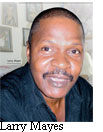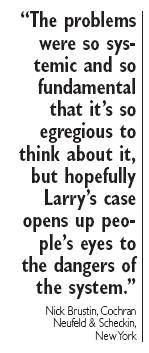Subscriber Benefit
As a subscriber you can listen to articles at work, in the car, or while you work out. Subscribe NowLarry Mayes spent decades behind bars for a rape he claimed from the start he didn’t commit. It took more than 20 years, but the Gary man proved his innocence. He was the 100th person in the U.S. and one of six from Indiana who’ve been exonerated, a trend that’s becoming more common as science evolves and cold-case reviews expose flaws in the criminal justice system.
Mayes was exonerated four days before Christmas 2001, after DNA evidence finally freed him by proving he hadn’t raped the female service station clerk in Hammond. He knows that part of his story is long since finished, but a second chapter post-exoneration has recently culminated for Mayes, who is now 58 and working to rebuild his life.
 Though Indiana is a state that doesn’t currently have any statutes that allow for compensating those wrongfully convicted, Mayes has gotten some compensation for what he went through. It took seven years, but in early September he settled a federal civil rights suit against the city of Hammond for $4.5 million. While it’s less than a quarter of what his attorneys originally requested and half of the $9 million federal jury verdict returned in his favor in August 2006, Mayes is relieved his case and that chapter of his life is now finished.
Though Indiana is a state that doesn’t currently have any statutes that allow for compensating those wrongfully convicted, Mayes has gotten some compensation for what he went through. It took seven years, but in early September he settled a federal civil rights suit against the city of Hammond for $4.5 million. While it’s less than a quarter of what his attorneys originally requested and half of the $9 million federal jury verdict returned in his favor in August 2006, Mayes is relieved his case and that chapter of his life is now finished.
“I just couldn’t believe they’d put someone innocent away like they did,” Mayes said, reflecting on his wrongful conviction. “I’d heard people talk about this, but I never would have believed it until I experienced it for my own self. But it does happen, and it’s been a long, hard road.”
In 1982, a jury sent Mayes and another man to prison for abducting and raping a gas station clerk during an armed robbery in October 1980. The woman told police that two black men entered the station, demanded money at gunpoint, and then forced her to leave with them. They hit her with the butt of the gun and raped her before dropping her off where she contacted police, according to case records. At trial, the prosecution relied on the clerk’s description and identification of Mayes from a photo array. She also said her assailant had a gold tooth similar to the one Mayes had.
When modern DNA analysis became available and Mayes petitioned for that testing, the victim revealed for the first time that she had been hypnotized in order to sharpen her memory of the attack. His attorneys argued, and Mayes still believes to this day, that police were squeezing him for information on an unsolved murder of a Hammond police officer and were not satisfied by his claim of ignorance.
Mayes refused to plead guilty, maintaining his innocence and expecting that at some point a court or attorney would give him the chance to prove they had the wrong man.

“I knew deep down inside that if they ever gave me the chance to say it, I could get out because I wasn’t there,” he said.
However, he said no one listened, and as a result he went into the Department of Correction for what would end up being 20 years, 10 months, and 20 days for a crime he didn’t commit.
Proving his innocence
Few words can describe the time behind bars, Mayes said.
“It’s a man-made hell, a day-to-day struggle to survive,” he said. “They took all of my freedom, but I never gave up hope that I could get out. I had to keep the faith that I’d get out. You drink water, pull yourself up each morning, and do what you have to. If I go crazy, then it defeats the purpose of everything I’ve done and all the times I’d said I was innocent.”
His thoughts often turned to the Hammond police investigator who he said years earlier taunted him, telling Mayes he wouldn’t see the outside as a free man until after age 70. That memory nagged at him, but he didn’t lose hope.
 A way to solidify that hope came one day when he saw an episode of “The Montel Williams Show.” Someone mentioned a group called the Innocence Project that was helping clear the wrongfully convicted. He wrote a letter and kept writing. He eventually got a response – albeit three or four years later.
A way to solidify that hope came one day when he saw an episode of “The Montel Williams Show.” Someone mentioned a group called the Innocence Project that was helping clear the wrongfully convicted. He wrote a letter and kept writing. He eventually got a response – albeit three or four years later.
The Innocence Project, which accepted his case in 1996, works with students at the Benjamin Cardozo School of Law in New York City, where the organization was founded in 1992. Law faculty and students there eventually referred the Mayes case to the criminal defense clinic at Indiana University School of Law Indianapolis, where professor and attorney Fran Watson studied wrongful-conviction cases. She and her clinic students are part of a national collaboration of law schools known as the Innocence Network, which works with the Innocence Project and is dedicated to raising awareness about the failings of the criminal justice system and those wrongfully convicted. Four students – Todd Ess, Edward Queen, Alicia Corder and Darlene Seymour – worked with Watson, who was appointed by state public defender Susan Carpenter as pro bono counsel for Mayes. They filed a petition for post-conviction relief based on Indiana’s newly passed Indiana Code 35-38-7, which had taken effect July 1, 2001, and allowed DNA testing for postconviction proceedings in murder cases.
The two met two or three times a month, and Mayes remembered her telling him she believed that he was innocent. Watson and her clinic students have filed appearances in 10 to 15 wrongful-conviction cases over the years, but Mayes is the only exoneration so far that they’ve helped achieve.
Aside from Watson and the law students, Mayes also had attorneys John Stainthorp with the People’s Law Office in Chicago and Nick Brustin with Cochran Neufeld & Scheckin in New York. Mayes describes them all as his “dream team.”
He remembers the phone call from Watson, telling him the news of the DNA testing results.
“When I heard her hollering on the phone, saying ‘Larry, Larry, Larry.’ I knew that I was finally going home,” he said. “They’re more than lawyers. They’re good lawyers, but they are family to me.”
After exoneration
Within two years of his release, Mayes filed a federal suit in the Northern District of Indiana alleging civil rights violations and a pattern of misconduct by police. Following a 12-day trial, a jury returned a verdict in Mayes’ favor in the amount of $9 million. While the verdict was out on appeal, Hammond officials and Mayes’ attorneys agreed in March to settle the case out of court for $4.5 million – that meant the court needed to vacate the jury award.
The 7th Circuit Court of Appeals in Chicago refused to do that, even though U.S. Magistrate Judge Paul Cherry in Hammond was inclined to set aside the verdict and many appellate courts across the country automatically vacate lower judgments in order to promote settlements. The 7th Circuit’s three-judge panel cited concerns about wasting judicial resources, but eventually in late August the appellate court agreed to remand the case and allow Magistrate Cherry to abandon the verdict. That happened Sept. 2.
Despite the verdict and settlement in his favor, Mayes makes it clear he has no faith in the legal system. Brustin echoed similar feelings but said he is doing what he can to address these types of problems.
“Larry is a good example. He’s someone who wasn’t a choirboy; he’d had run-ins with the law before, and these detectives decided his basic constitutional civil rights don’t matter,” Brustin said. “The problems were so systemic and so fundamental that it’s so egregious to think about it, but hopefully Larry’s case opens up people’s eyes to the dangers of the system.”
Mayes said he never thought it would take this long for the federal suit to play out, and he admits being nervous about the 7th Circuit’s hesitation to vacate the jury award. He has a heart condition that has made it difficult to work steadily, and he’s had to rely on odd jobs and help from family and friends. His life insurer determined that Mayes has the life expectancy of someone almost 20 years older. Though he believes he could have eventually gotten the $9 million award, he said it wasn’t worth the continued legal battle.
“I wanted to come out of this with something and not take a chance to not get anything,” he said. “I felt that it would be best for me to try and get a settlement, because it could be many more years.”
Now, he is working to put his life back together. Mayes and his fiancée are planning for a possible June 2009 wedding, and they are working with a Realtor to move from their apartment in Portage to a house in the region.
“You can’t ever make up for that time,” he said, “but you can enjoy what time you have left.”
Read "System delivers in justice" , from the Sept. 17-30, 2008, issue of Indiana Lawyer to learn more about exonerated individuals and the attorneys who assist them.
Please enable JavaScript to view this content.
